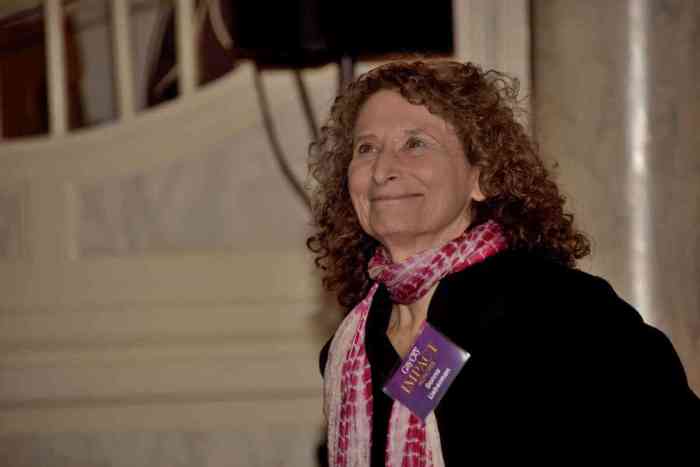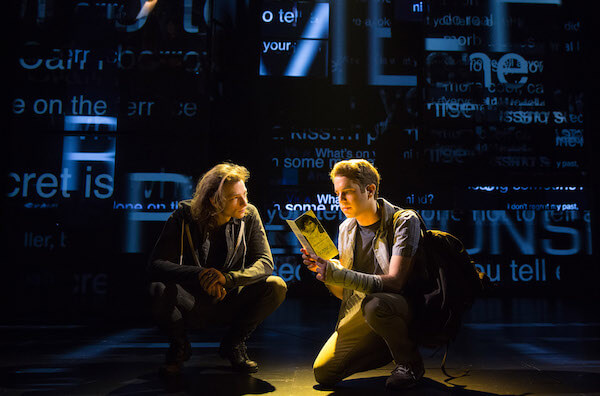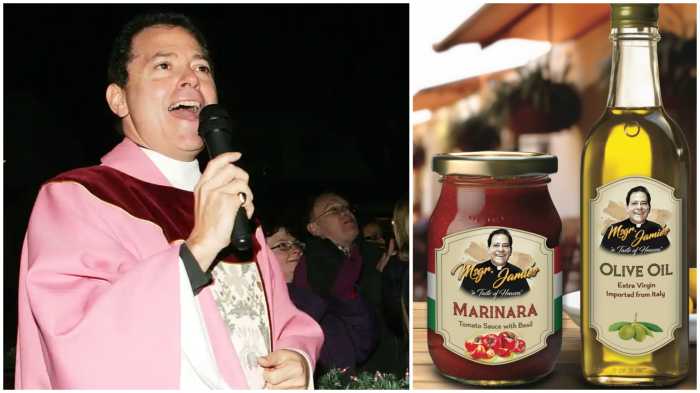Daveed Diggs, Okieriete Onaodowan, Anthony Ramos, and Lin-Manuel Miranda in Miranda’s “Hamilton,” directed by Thomas Kail. | JOAN MARCUS
The new musical “Hamilton” now at the Public Theater owes its inspiration partly to Ron Chernow’s exhaustive biography “Alexander Hamilton” and partly to the animated TV series “Schoolhouse Rock!” The latter was a series of Saturday morning animated shorts that ran from 1973 to 1999 and were designed to make sophisticated concepts accessible to kids through song and rhyme. I mean the comparison as a compliment.
Lin-Manuel Miranda’s musical — he’s responsible for the book, music, and lyrics — is a dynamic rap and R&B-infused, sung-through romp traversing Hamilton’s life and the dawn of the American experiment. The immediacy of the storytelling and the contemporary expression naturally invite comparison with historical musicals such as “Bloody, Bloody Andrew Jackson,” which was more antic, “Here Lies Love,” which was more concept-driven, and, of course, “1776,” which was more reverential toward the history. The narrative structure is linear, tracing Hamilton’s life from the West Indian island of Nevis to New York, through the Revolutionary War and the establishment of the United States, and ends, almost, with his death at the hands of Aaron Burr in a duel. Miranda has infused the story with undertones that resonate deeply today — including sex scandals, financial intrigues, and the impact of immigrants. As they say, the more things change…
The American Revolution, the British monarchy are fresh and entertaining in two new shows
What works so well in all this is the development of the characters. Hamilton is an over-eager, passionate, and dedicated man. His failings — a sexual affair, his inappropriate affection for his sister-in-law, and his belligerence — are perfectly suited to the rap and R&B score Miranda has created. And Miranda deserves high marks for turning a debate on monetary policy into a heart-pounding duet. There are a few moments when rap lyrics feel as though they've been poleaxed into place, but for the most part they are extraordinary, with internal rhyme structures that are simply brilliant. Miranda has established himself as a great contemporary lyricist.
The one discordant note in the piece is the depiction of King George III as a petulant fop. In fact, the need to portray him in the conventional theatrical shorthand for gay is lazy and an easy laugh that doesn’t even attempt to sketch in the realities of the character. There may not be time to get into the complexities of British politics that George faced, but the portrayal is nonetheless gratuitous and glaringly out of place. Still, the king’s song “You’ll Be Back” is funny, and in this brief role Jonathan Groff, done to the teeth in velvet and ermine, is delightful. You will probably laugh, but it’s still a cheap shot.
Miranda in the title role is extraordinary, displaying the buoyancy bordering on manic that he had in his previous show, “In The Heights.” Here, he’s acquired a focus that applies that energy in service of a more complex, conflicted character. At times, there are unexpected depths of feeling in his Hamilton.
The rest of the cast is uniformly excellent. Leslie Odom, Jr. is outstanding as Burr, and there are powerful performances from Christopher Jackson as George Washington, Phillipa Soo as Eliza Hamilton, and Renée Elise Goldsberry as Angelica Schuyler. Of the supporting characters, though, the standout is Daveed Diggs as Marquis de Lafayette and later Thomas Jefferson. Diggs has star quality to be sure, but he also has an extraordinary voice and a facility with the complexities of the music that is remarkable.
David Korins’ typically ingenious scaffold set is versatile and gorgeous. Howell Binkley’s lighting design is appropriately theatrical, making great and subtle use of color, and Paul Tazewell’s costumes and Charles G. Lapointe’s hair and wigs evoke the period splendidly.
Thomas Kail’s sharp direction and Andy Blankenbuehler’s inspired choreography keep the show crackling —and audience members on the edge of their seats — throughout.
It would be a real downer to end with Hamilton’s death, and Miranda wisely delivers a big, upbeat ending that celebrates his legacy, which went unappreciated in many quarters in his era. Though it is no novel concept, “Hamilton” concludes by making the point that the history we perceive is in the hands of who tells the story. Fortunately for history, audiences, and the contemporary musical theater, Hamilton’s story is in very talented hands.
Helen Mirren and Richard McCabe in Peter Morgan’s “The Audience,” directed by Stephen Daldry. | JOAN MARCUS
For a democracy, we Americans sure love royalty. Queen Elizabeth II and her family are endlessly fascinating — through weddings, funerals, and 12 prime ministers over the past 60-plus years. While no one outside the inner circle may ever really know HRH, the new play “The Audience” provides a tantalizing view of who she might be. As Shakespeare wrote of Henry V, the monarch is always someone upon whom the common people project their lives and perceptions to make him or her accessible.
Peter Morgan’s delightful play “The Audience” purports to give us a view of Queen Elizabeth through her weekly audiences with the prime ministers who have served during her reign. We see a young woman grappling with her fate along with a very seasoned Winston Churchill, the difficulty of the Suez crisis with Anthony Eden, and Elizabeth’s warm relationship with Harold Wilson. The story, bouncing back and forth across time, hits both history’s high points and the human interactions at play behind the scenes, while the queen’s equerry who shepherds the PMs in and out also offers some interesting facts about the castles and their contents. In addition to the prime ministers, Elizabeth also interacts with her younger self in memory scenes that imagine what the young queen might have felt about the role thrust on her at such a young age. As both history and character study, “The Audience” is a warm and appealing piece.
What makes this work — as was the case with Morgan’s 2006 film “The Queen” — is the radiant Helen Mirren. She had practice in the film, but here Mirren shows her magnificent gifts as a stage actress, handling the various ages of Elizabeth with a precision, fluidity, and honesty that make the character fascinating, human, and believable at every age. Mirren is aided in her masterful illusion by the recognizable costumes — to any dedicated royal watcher — and the team who transform her from age to age largely on stage.
Director Stephen Daldry does a wonderful job of keeping the play moving and making the vignettes work together as a comprehensive whole, and designer Bob Crowley gives it all just the look you would expect. To paraphrase one of Elizabeth’s predecessors, we were very amused.
HAMILTON | The Public Theater, 425 Lafayette St. btwn. E. Fourth St. & Astor Pl. | Through May 3: Tue.-Sun. at 8 p.m.; Sat.-Sun. at 2 p.m. | $95 at publictheater.org or 212-967-7555
THE AUDIENCE | Gerald Schoenfeld Theatre, 236 W. 45th St. | Through Jun. 28: Tue., Thu. at 7 p.m.; Fri.-Sat. at 8 p.m.; Sat. at 2 p.m.; Wed., Sun. at 3 p.m. | $79-$157 at telecharge.com or 212-639-6200



































